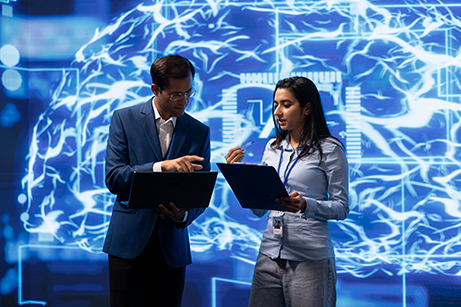AIMC Topic: Illusions
Clear Filters Showing 1 to 10 of 11 articles
Illusion, dilution, or loss: psychological ownership and GenAI.
Trends in cognitive sciences
Jan 7, 2025
Generative artificial intelligence (GenAI) reshapes and challenges psychological ownership of created content. This article examines how GenAI disrupts original content creators' and GenAI users' sense of ownership and control and illustrates how bot...
Artificial intelligence and illusions of understanding in scientific research.
Nature
Mar 6, 2024
Scientists are enthusiastically imagining ways in which artificial intelligence (AI) tools might improve research. Why are AI tools so attractive and what are the risks of implementing them across the research pipeline? Here we develop a taxonomy of ...
The history of robotic surgery and its evolution: when illusion becomes reality.
Revista do Colegio Brasileiro de Cirurgioes
Jan 13, 2021
The term "robot" was concepted in the beginning of last century, coming originally from the Czech word "robota", meaning "labor". More recently, computer assistance and robotics based in the telepresence and virtual reality concept have been applied ...
Robotic hand illusion with tactile feedback: Unravelling the relative contribution of visuotactile and visuomotor input to the representation of body parts in space.
PloS one
Jan 23, 2019
The rubber hand illusion describes a phenomenon in which participants experience a rubber hand as being part of their body by the synchronous application of visuotactile stimulation to the real and the artificial limb. In the recently introduced robo...
Influence of Size-Weight Illusion on Usability in Haptic Human-Robot Collaboration.
IEEE transactions on haptics
Sep 29, 2017
Collaborative power amplifying robots are accepted as one solution to overcome flexibility and ergonomic issues in future work and life scenarios. The handling of various sized and weighted objects in heterogeneous environments pose a particular chal...
Spatio-Temporal Tolerance of Visuo-Tactile Illusions in Artificial Skin by Recurrent Neural Network with Spike-Timing-Dependent Plasticity.
Scientific reports
Jan 20, 2017
Perceptual illusions across multiple modalities, such as the rubber-hand illusion, show how dynamic the brain is at adapting its body image and at determining what is part of it (the self) and what is not (others). Several research studies showed tha...
Visualization Method for Proprioceptive Drift on a 2D Plane Using Support Vector Machine.
Journal of visualized experiments : JoVE
Oct 27, 2016
Proprioceptive drift, which is a perceptual shift in body-part position from the unseen real body to a visible body-like image, has been measured as the behavioral correlate for the sense of ownership. Previously, the estimation of proprioceptive dri...
The second me: Seeing the real body during humanoid robot embodiment produces an illusion of bi-location.
Consciousness and cognition
Sep 28, 2016
Whole-body embodiment studies have shown that synchronized multi-sensory cues can trick a healthy human mind to perceive self-location outside the bodily borders, producing an illusion that resembles an out-of-body experience (OBE). But can a healthy...
Why scientists trust AI too much - and what to do about it.
Nature
Mar 1, 2024
A biologically inspired neurocomputational model for audiovisual integration and causal inference.
The European journal of neuroscience
Nov 1, 2017
Recently, experimental and theoretical research has focused on the brain's abilities to extract information from a noisy sensory environment and how cross-modal inputs are processed to solve the causal inference problem to provide the best estimate o...
Popular Topics
- Machine Learning 31964
- Neural Networks, Computer 30201
- Algorithms 27375
- Deep Learning 26880
- Artificial Intelligence 24818
- Robotics 13382
- Image Processing, Computer-Assisted 9730
- Retrospective Studies 9328
- Magnetic Resonance Imaging 6341
- Reproducibility of Results 5670
- Tomography, X-Ray Computed 4863
- Support Vector Machine 4762
- Computational Biology 4328
- Brain 4125
- Computer Simulation 3932
Recent Journals
- Scientific reports 6689
- Sensors (Basel, Switzerland) 4794
- PloS one 4186
- Neural networks : the official journal of the International Neural Network Society 3026
- Computational intelligence and neuroscience 1931
- Computers in biology and medicine 1915
- Annual International Conference of the IEEE Engineering in Medicine and Biology Society. IEEE Engineering in Medicine and Biology Society. Annual International Conference 1686
- Studies in health technology and informatics 1378
- IEEE journal of biomedical and health informatics 1167
- Journal of chemical information and modeling 1059
- Nature communications 1029
- Computer methods and programs in biomedicine 883
- Bioinformatics (Oxford, England) 872
- Journal of medical Internet research 853
- Briefings in bioinformatics 853
